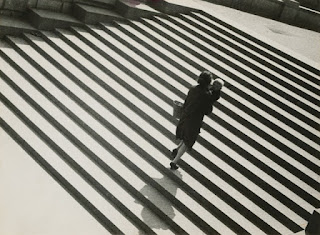“Artificial Beauty” is composed of eight black and white photographs. These images represent the abundance of makeup products I noticed when coming to Stirling in comparison to where I am from.
My work is influenced by Alexander Rodchenko (1891-1956), particularly his photograph The Staircase, which features intense diagonals and cropping that is unusual compared to what I’ve learned in traditional photography classes. I was also inspired by Alma Lavenson (1897-1989), who shot ambiguous photos of herself, showing an unclear perception of who she really was. This is why I chose to show hands holding lipstick and part of a face cropped and reflected into a mirror in my images, because these body parts didn’t portray the identity of a specific person. I chose the topic of makeup specifically because I feel as though it is heavily emphasized in the UK. The malls where I’m from and where I go to university in America both don’t have any makeup stores, yet Stirling’s, which is a smaller town, has at least two. A large portion of the University of Stirling’s pharmacy is dedicated to makeup, the mouse pads in the 24/7 lab feature a brand of concealer, and in the bigger cities, huge displays of models are featured in many shop windows. Early modernist photographers used social issues as subject matter, and I feel that my using the excessive abundance of makeup as a topic shines a light on consumerism, and a desire to purchase products completely unnecessary for human survival or improving the quality of life.
"Artifical Beauty” tells a story of a girl going to the store, becoming overwhelmed by the selection of makeup, finally picking some out and buying it, putting it on, and then what little remains of it at the end of the day. The use of intense angles in the first half of the series symbolizes the chaos of being faced with so many choices. The alternation of the direction of the angles from one image to another creates successful flow. By using mirrors and windows for the last portion of my series, I managed to capture tools for the application and removal of makeup in completely natural lighting. I chose to use a black and white colour scheme for the series not only to pay homage to original modernist photography, but also to show that although in real life the multitude of colours that makeup is available in are visually appealing, the display and concept becomes significantly less exciting when that element is removed.
Although the concept of makeup is trivial in comparison, I was inspired by El Lissitzky’s (1890-1941) ability to use photography to promote soviet patriotism in a positive light and convey equality among men and women. Some viewers may not understand my series, but I hope that the lengths that some women go through in order to feel confident, or even acceptable, are portrayed and that society’s misconceptions about beauty are thought about critically by viewers.
Inspired by the bold statements modernist photographers could convey with simple images, I have attempted to present a strong message to my viewers. Society should be ashamed for tricking girls into thinking they aren’t pretty enough for monetary gain, and consumers should also be upset for buying into it for so long. I would like to inspire people to reconsider spending money on huge quantities of designer makeup because at the end of the day, all you are left with are a few smudges on a cotton pad headed for the trash.











































